Click on images to enlarge
There can be no doubt that Marie Severin deserves a book about her lifelong efforts in comics. More recognition than that would be appropriate even if she wasn’t one of the few well-known female practitioners in the last century. One would think that for her essential role as E.C.’s colorist alone, Severin should at least have previously had an issue of Squa Tront dedicated to her, since a special edition of that beautifully-produced E.C. fanzine is thus far the only significant acknowledgement that her brother the late John Severin has recieved from the American comics industry to which he dedicated decades of consistently high-quality, naturalistic work. But so far, the only publisher to undertake the rightful honoring of Severin is TwoMorrows, the imprint that fan John Morrow grew from the humble beginnings of his first thin issue of The Jack Kirby Collector in 1994.
Not only is coloring a particularly misunderstood aspect of comics, but the efforts of women have been traditionally discouraged in the medium. And though there is now occurring an explosion of comics scholarship, those scholars are often more interested in analyzing printed comics than they are in talking to the humans who made them. Since the higher-end critical forums such as Fantagraphics’ Comics Journal and Todd Hignite’s Comic Art are now published annually or otherwise infrequently, the bulk of in-print documentation and discussion of previous generations of cartoonists has been left to such publishers as J. David Spurlock’s Vanguard Productions and Morrow’s TwoMorrows, which also puts out Roy Thomas’ zine Alter Ego, the primary venue for many elder cartoonists’ only (or final) interviews.
So, TwoMorrows has published a book about Marie Severin and for that I am grateful. Nonetheless, this book, which features interviews by Dewey Cassell and Aaron Sultan with the artist and her contemporaries, shows the best and worst tendencies of the explosion of unapologetically fannish tomes that TwoMorrows has been releasing in the last few decades. The bad is overshadowed by the good, so let me get the few outstanding deficiencies out of the way immediately. The most heinous offense committed here is that the book is subtitled The Mirthful Mistress of Comics.
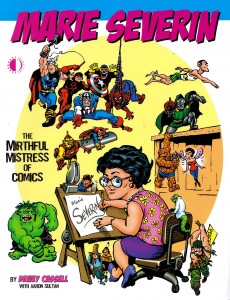
Severin is known for having a clever and cutting sense of humor. However, in utilizing Marvel overlord Stan Lee’s nickname for Severin (“Mirthful Marie”) and adding the usually pejorative feminine descriptive “Mistress,” the artist’s versatility and the essential nature of her many and varied contributions to comics history are diminished, even as images of a sort of cackling floozy ensconced seductively in the predominantly male confines of the bullpen are conjured.
One is relieved that other books about Marvel’s artists don’t all similarly utilize Lee’s corny alliterations; that, for instance, the many books about Jack Kirby have in their titles avoided Lee’s appending of “Jolly” to the artist’s name, since it is an even less appropriate description of Marvel’s founding dynamo than the unbecomingly anti-democratic royalism of the more familiar “King”. Speaking of Kirby, a bizarre prejudice rears up when co-interviewer Sultan asks Marvel mainstay John Romita, “What about Marie and Jack Kirby? Did she ever resent his ego at all?” Romita sets Sultan straight in short order, telling him of Severin’s (and his other contemporaries’) absolute admiration of the humble and accessible Kirby.
The other drawbacks here are lackluster book design and the counterintuitive use of the color section. For an artist known primarily if dismissively as a colorist, the decisions regarding color here are hard to fathom. Of 16 pages allotted for color reproduction, the equivalent of five of those pages are taken up by reproductions of original art, i.e. black and white linework and the other pages do not well represent Severin’s best work. Her important and exemplary early E.C. coloring is shown in 4 small reproductions on a single page. Perhaps Cassell and TwoMorrows were unable to get the rights to use larger reproductions by those who hold the copyrights to her work for E.C., and so this specific disservice to Severin is not their fault. But as can be seen in the covers below, Severin added significantly to the art of such luminaries as Graham Ingels, Wally Wood and George Evans.
The strength of TwoMorrows’ books is usually in the varied interviews and such is the case with Marie Severin: the Mirthful Mistress of Comics. The authors speak to her brother, to her childhood friends and to her surviving co-workers at E.C. and Marvel. I wish that there were comments by more of the now-deceased artists that Severin colored over the years and who respected her efforts such as Kirby and that her employers such as Stan Lee had graced the book with more than perfunctory tribute. However, there are substantial contributions by such reputable sources as Al Feldstein, Jack Davis, Jack Kamen, John Romita, Roy Thomas, Flo Steinberg, Herb Trimpe, Linda Fite, Ramona Fradon, Trina Robbins, David Anthony Kraft and Mark Evanier.
The E.C. section is particularly well done. Severin began coloring for them when editor Harvey Kurtzman wanted to upgrade the look of the books, in Severin’s words “to look more like Prince Valiant in the newspaper.” For the next few years she colored first Kurtzman’s war books, then the entire line, with the exception of some covers and stories colored by the perfectionist Kurtzman, as well as a few stories colored by the similarly autonomously-minded Bernard Krigstein (both of whom Severin typically characterizes as “artsy-fartsy”). When Cassell tells Severin, “you’ve been credited with a lot of the success of EC because of those vibrant covers,” she effaces herself to credit instead the quality of the “content,” but truly, covers are the primary selling factors on the newsstand and the color is the more significant part of the initial impact of the visuals on the reader. And, Severin’s interior coloring is no less sensitive and considered. Still, assisting Kurtzman on his comprehensive research, drawing caricatures on the fly of her co-workers and coloring were the art Severin was able to do at E.C.
She was always capable of more, but it wasn’t until the 1960s and she had been working at Marvel for a while that she was given the opportunity to draw comics herself. It wasn’t the usually canny Stan Lee who realized her talents, either; instead it was Marvel’s publisher Martin Goodman that noticed how good she was when she did some superhero drawings for Esquire and so Severin began to draw sporadically for the company: a few episodes of Dr. Strange here, issues of The Hulk and Sub-Mariner there. Severin understands the comics medium well and her work can be as energetic and muscular as that of any male superhero artist, even on her many strips for the Marvel humor titles Not Brand Echh and Crazy.
Perhaps her best known Marvel Comics work is her early-seventies tenure on their adaptations of the Robert E. Howard hero Kull the Conqueror; these stories are beautifully inked by her brother John. Their collaborative run is considered to be a classic of adventure comics and both siblings certainly deserve credit, but it is Marie’s great storytelling skills that drive the narratives. And, she is one of the few artists in comics who can match Kirby for compositional thrust, which is why she became the chief cover designer for Marvel for the next few decades.
The interviews in the book give a remarkable account of Severin’s career and personality, but one gets the sense that Cassell and Sultan don’t truly comprehend how difficult and abusive the workplace was for women in the last century. That may be in part because Severin herself tends to diminish progressive issues that might be seen to be about political correctness, but it is sometimes only by reading between the lines that a fairly full picture of what her life in comics was like emerges. There can be little doubt that the sexual innuendos in the office went beyond simply “forgetting” about the presence of women in the room, that unwelcome comments and physical advances were directed to them. And Severin definitely faced a glass ceiling.
She succeeded John Romita to operate as a virtual art director for Marvel, but the position was unheralded as well as unpaid. In the present volume, Romita actually details how in order to gain points with Goodman, Stan Lee took credit for the substantial extra work that he and Severin did in that capacity. This seems typical of Lee’s manipulative treatment of even his most stalwart workers (and there is even mention here of Lee claiming as his property substantial amounts of original artwork, a questionable provenance at best given the subsequent troubled legal status of those pages). Neither Romita nor Severin hold anything against their “fearless leader”—it seems that Lee casts a sort of magic spell of obvious bullshit to make the people he uses, but never sticks up for, still somehow love him. Later, when Jim Shooter cut a vicious swath through Marvel’s elder talent, he also disrespected Severin’s art directorship, calling her instead “head artist” and she had no choice but to endure; as usual, there was no one in upper management to take her side.
Flying against Severin’s conservative nature, Trina Robbins hails her as a true feminist and she surely is an example of a woman excelling in a male-dominated field through sheer perseverance. Severin had a career in comics, but was not facilitated as she should have been; it was with her sense of humor that she was able to shine.
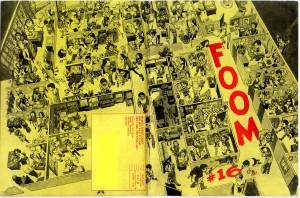
Marvel editor David Anthony Kraft on Marie Severin’s cover for the in-house fanzine FOOM #16: “That is exactly how the office looked….She’s got everyone in character, in the place where they were in the office, doing what they did.”
Severin’s ability to effectively nail her contemporaries is impressive, but these rare skills are unfortunately easy for some to underestimate; in the end she had to take what she was given and put a smiling face to it. Perhaps the most telling testimony to Severin’s skills and the misuse of her talents by the comics companies she worked so faithfully for is provided here by Mark Evanier. Firstly, in reference to MAD magazine, begun under the banner of her first employer E.C. and more recently published by DC Comics:
“People used to always say, ‘Marie belongs in MAD magazine.’ And she did…And I hate to think it’s true, although it possibly is, that the reason that she wasn’t was that she’s a woman. If you noticed, while Bill Gaines was running MAD magazine, they never had a woman artist there…Every so often, they would tap her for a coloring job, or a production job, but they never thought of her as somebody who could actually draw, say, a movie parody. And she would have drawn a better parody than a lot of other people they used. She obviously could do likenesses and at that time, MAD was paying ten times what a Marvel artist was getting paid for a page. It would have been fascinating to have seen her spend two days drawing a page of comics, as opposed to three hours. I would have loved to have seen what she would have done because it would have been amazing…she was considered family up there and they loved her, but she was family for production…I think she should have been drawing for MAD, because she was so good, and if a guy had been doing that same quality of work, probably would have been a regular in MAD. She probably would have had the job that Angelo Torres ended up getting…(doing) movie parodies up there.”
—and at Marvel:
“…I always thought she was an amazingly talented artist. She probably should not have been doing super-hero or adventure comics, but when she did, she always did a very fine job of them. I just thought she had this wonderful sense of humor…it is a shame, to me, that Marvel never really did a project where they let Marie Severin work exclusively on humor material, and develop her style more, and encourage her, and let her be as wonderful as she could be, because she had the skills, obviously, she had the sense of humor, and she had a unique viewpoint.”
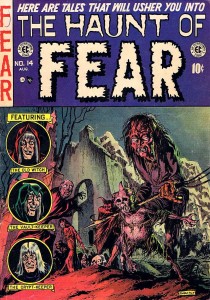
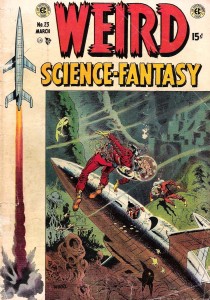

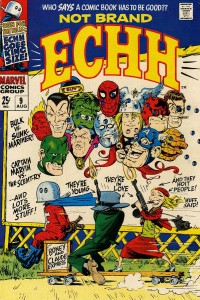
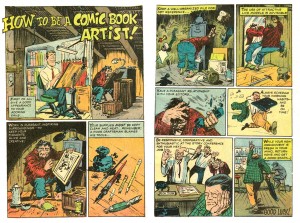
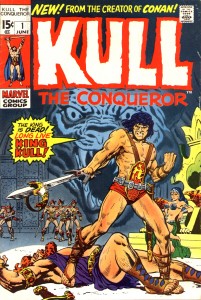
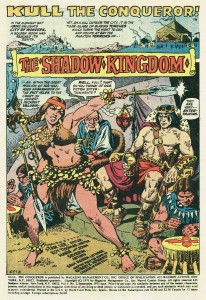
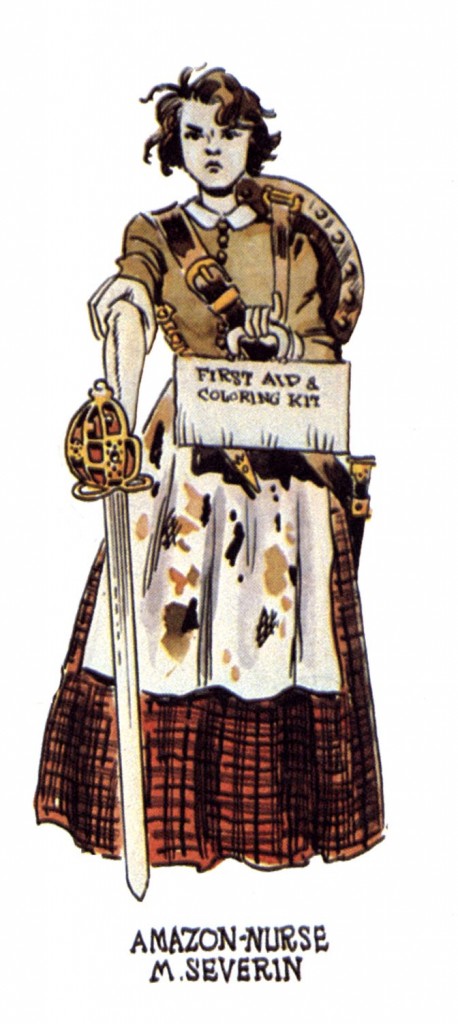
Definitely on my must-get list.
She was on salary for something, though, at Marvel?
About those Stan epithets… Neal Adams really disliked being dubbed ‘Nefarious Neal.’
John Severin wasn’t easily approachable for much of his career, living as he did in the wilds of the Rockies…nonetheless, he gave a great interview for TCJ. And there’s tons of his comments in the Cochran books.
Thanks for this review. For all its problems, it sounds like a worthwhile book. Worthwhile subjects overcome a lot of flaws.
Severin’s Doctor Strange work can be found in the first volume of the Essential DS. Her episodes are the best apart from Ditko’s.
Does the book get into conflicts Severin had with Jim Shooter at all? I know we have different views of Shooter, but I’m curious about all sides of the stories with him.
Yes, I mentioned a problem Severin had with Shooter above…typical for him. And the book is certainly worthwhile, content-wise. An odd thing about the problem with weak design on the more recent TwoMorrows books is that when John started out, the design of his publications was quite strong.
That Foom cover is something else.
Yes!
As historically important (and admirable) as her coloring work was, Marie Severin was a brilliant humor artist; in “Crazy” and “Not Brand Echh” superbly nailing down celebrity likenesses, her old-school mastery and lucidity of composition making the physical humor even funnier, in the same fashion that Buster Keaton’s deadpan mug does.
She was (is the retired?) an able superhero artist (four pages of a “Prince Namor, the Sub-Mariner” story by her at http://goodcomics.comicbookresources.com/2012/05/13/when-we-first-met-marvel-comic-magical-objects/ ), if not an inspired one. (I can hear Domingos laughing at the very idea of an “Inspired superhero artist.) Held back in that her “serious” characters could lapse into borderline silly-looking: see the goon at right at http://girl-wonder.org/dimestoredames/wp-content/uploads/2011/09/tigra1.png . (Jack Davis, somehow, could get away with this.)
Her humor work really allows her rendering exuberance and sense of fun to shine:
http://24.media.tumblr.com/tumblr_m93755WaWX1qzoglfo1_500.jpg
http://2.bp.blogspot.com/_0WGbbAaNY6w/TElKTAdmYvI/AAAAAAAAGTk/qWGlMHh2U04/s1600/Alter%2BEgo%2B95.jpg
Marie Severin and Kirby humor-work at http://animationresources.org/?cat=284
http://www.coollinesartwork.com/featured.asp?Piece=293565&Details=1&From=Room
http://www.coollinesartwork.com/featured.asp?Piece=293566&Details=1&From=Room
…Which is nothing to sneeze at; imagine Mort Drucker drawing a “serious” story: yawn!
But rather than “Mistress” being “usually pejorative,” it’s the female equivalent of “master”; employed for wealthy Edwardian ladies of the household and dominatrixes.
——————-
mis·tress
1. a woman who has authority, control, or power, especially the female head of a household, institution, or other establishment.
2. a woman employing, or in authority over, servants or attendants.
3. a female owner of an animal, or formerly, a slave.
4. a woman who has the power of controlling or disposing of something at her own pleasure: mistress of a great fortune.
5. ( sometimes initial capital letter ) something regarded as feminine that has control or supremacy: Great Britain, the mistress of the seas.
6. a women who is skilled in something, as an occupation or art.
7. a woman who has a continuing, extramarital sexual relationship with one man, especially a man who, in return for an exclusive and continuing liaison, provides her with financial support.
8, British . a female schoolteacher; schoolmistress.
9. ( initial capital letter ) a term of address in former use and corresponding to Mrs., Miss, or Ms.
10. Archaic . sweetheart.
Origin:
1275–1325; Middle English maistresse < Middle French, Old French, equivalent to maistre master + -esse -ess
——————–
http://dictionary.reference.com/browse/mistress?s=t
#7 the only definition with negative connotations…
Actually, Mike, Mort Drucker did some absolutely first-rate ‘serious’ work, most notably war stories for DC in the ’50s.
That Foom cover IS completely amazing.
Sorry to hear that you didn’t care for my design work on the book. I will share my thinking on what to include in the color section as most of the choices were mine. Simply, I tried to cover as many aspects of her career in 16 pages as I could with the material I had available to me. The choice to show original art in that section was mine also and I don’t regret it as I enjoy seeing original art with the kind of fidelity that color images provide. FYI: Twomorrows has an ebook version of the book available that is in full color (and cheaper, too) and gives Marie’s work a bit better showing, especially in the first two chapters.
Scott: thanks for sharing your reasoning behind your choices. I’m less interested in seeing original art in that way, still, some are. I wasn’t aware that the digital version of the book has color throughout, although I knew that the digital versions of the Kirby Collectors do….it is some considerable incentive to read such books in that format. I was a bit hard on your design; some of it may be personal taste—many repros that I would have liked to see large were small, and vice-versa. Other than my issues with the color section, really the main problem to me is the cover: the (uncredited) color seems quite “candy-cane” and some better art continuity could have been implemented in adapting Marie’s self-portrait drawing. The desk lamp in particular is fragmented and needed repair. A small detail, but one I found disturbing.
I’m lucky enough to own an “Imperious Rex” page from Sub-Mariner with Marie’s pencils. One of the things I *love* about her serious work is that, like Wally Wood, her line seems to be filled with humor and glee, just about to break into laughter. It was never a detriment, to me, and I actually enjoyed her superhero work more (tho at this remove, I can easily see how tremendous her humorous work was).
The book is by no means perfect, of course, in part for the reasons that James outlines, but still, I enjoyed the heck out of it, thanks to my gigantic appreciation for Marie & her work; she, her brother & Russ Heath are my three favorite artists ever, period.
Of course, for me the highlight of the book is its inclusion of one of Marie’s cover-design roughs — for Capt. Savage #19, which happened to be the final issue of one of my favorite comics as a kid — that I bought from author Dewey Cassell via eBay maybe 5 years ago.
Oh, yeah. Since you wondered, Mike Hunter, she *is* retired.
I actually did not design the cover. It was presented to me as a done deal when I took on the project. I pretty much kept my energies and attentions on my own efforts on the interior — I get very focused when I work — but I do regret not speaking up about the lamp, it bugged me too. Despite such warts, I enjoyed the book quite a bit both as a designer and comic fan (I’ve read it at least 4 times) and am glad that John Morrow continues to spotlight deserving creators like Marie Severin especially while they are still alive.
—————-
Dan Bailey says:
Oh, yeah. Since you wondered, Mike Hunter, she *is* retired.
—————-
Thanks, I’m relieve to hear that! She kept getting referred to in he past tense, and I didn’t have the heart to Google and see that was no longer with us.
—————
Scott Saavedra says:
I …am glad that John Morrow continues to spotlight deserving creators like Marie Severin especially while they are still alive.
—————-
Indeed so! How for years I wished “The Comics Journal” would’ve devoted a career-spanning interview to this most deserving creator; glad she’s finally getting this well-merited in-depth look.
I thought I referred to the artist in the present tense except where I am talking about past work. I hope it is clear that I do value the book very much and that my criticisms are outweighed by the positive aspects of it. And, my complaints about Marvel’s, Stan Lee’s and Jim Shooter’s usual bad treatment of the people who put them on the map shouldn’t be taken as being directed against their victims in any way.
Pingback: Comics A.M. | Update on Cerebus negatives; rise of ‘foodie comics’ | Robot 6 @ Comic Book Resources – Covering Comic Book News and Entertainment
With regard to Shooter and the art director position, this is what Severin had to say:
Oh, that didn’t last long. I was just a fill-in. And Jim Shooter didn’t want me, he didn’t want anybody to be art director. He wanted to run it his way, which was his prerogative. So maybe three days.
(Note: link removed by article author)
To add to what he says, I know that series editors at Marvel then were responsible for traditional art-director responsibilities of assigning and overseeing the work of pencilers, inkers, and colorists. Changing the job title from “Art Director” to “Head Artist” doesn’t sound unreasonable.
Unless I’m missing something, it doesn’t seem like there was any serious conflict between Shooter and Severin.
RSM: Noah did not like that I censored you. It’s gone though and here’s a reworked response. I don’t want to read Jim Shooter’s opinions about anything or give credence to anything he says. I’m asking you to please not post links to his blog in the comments sections of my pieces. Thanks.
I am very leery of stepping in here…but I kind of feel like I should say something. So here goes.
As James said, I tend to feel that editing comments, or moderating comments, is my job. For some reason the software let’s authors edit all comments on their posts. I believe this has come up before as a problem, though wordpress is enough of a mystery to me that I didn’t really understand what was happening. Anyway, we’re trying to fix it so authors aren’t confronted with what is an understandable temptation.
As far as the substantive issue goes; I really don’t know anything about Jim Shooter. But in general on the blog I feel like the comments sections are there not just for authors, but for readers. I understand James’ disinterest and dislike of Shooter…but it seems like a reasonably related topic to the post, and if one person disses him (however justly) it then seems reasonable for others to dissent. The back and forth is what the comments threads are for (within limits of civility, of course.)
Everyone always has the option of just not continuing a conversation, of course. And if things get personal or uncivil or wildly unrelated to the topic, that’s another issue. And I’m not opposed to just having certain posts be without comments, if that’s the author’s preference (we’ve done it in a couple of cases before.) But in general putting certain topics or viewpoints off limits is not how I want the comments threads to work.
Sheesh, is there anyone here who would tend to give any credence whatsoever to anything comics-related that Jim Shooter says?
The Comics Journal called him “our [the comics industry’s] Nixon,” and he’s regularly been caught in, um, “fictionalizing reality.”
http://www.tcj.com/jim-shooter-groundhog-day-in-the-land-of-the-apocryphiars/
http://tonyisabella.blogspot.com/2011/09/jim-shooters-pants-are-on-fire.html
And Robert Stanley Martin wasn’t quoting Shooter, but quoting Marie Severin. I guess that the post was pulled from Shooter’s blog (the link provided so RSM could prove he didn’t invent it) was the irritating factor.
Okay; tried closing the thread, but no one seems happy with that option. James, rightly, feels like Marie Severin doesn’t get enough attention as it is, so it’s not a good option to close down a thread about her.
Robert, for his part, wanted to restore the link, and respond to some confusion in Mike’s comment caused by the deletion. Robert sent me the comment while the thread was closed; it’s below:
As Robert says, he’s going to discuss Shooter in a post at some point in the not-too-distant future, and I think that’s the best place to deal with these issues. I know it’s tempting to have at it here, but I would appreciate if all involved (Robert, James, Mike, everybody) could resist, please — not least because I will delete Shooter related discussion on this thread after this point, and so everyone will be wasting their breath (or keyboards.) There’ll be plenty of time to get into it later.
My apologies for the confusion and unpleasantness. Thanks all.
And, in the interest of trying to get the conversation vaguely back on track…I’ve at least heard I think that many colorists over the years for comics have been women. Were there other women colorists working at the time that Severin was? And did colorists often also do pencilling, like Severin, or was that unusual?
Must say, looking back on the EC covers that the Tomorrows article published made me go out to search for more. I always knew how important a colorist she was, but the gradations were as exciting as any digital coloring being done, today. Simply beautiful work. I wish some publication wd do a one-or-two to a page presentation of her EC covers.
Noah: It’s my understanding that for a long time the coloring for… Marvel?… was done anonymously by some place that primarily employed women. I’m sure there’s someone more knowledgeable who will come in with the specifics.
It is my impression that Severin colored all of the classic E.C. covers except for some of the war book covers that Kurtzman did himself….but she began coloring for E.C. on those same war books and didn’t specify which ones were done by Kurtzman, so I ‘d guess that she did most of the covers and nearly all of the interiors of the entire E.C. “New Trend” line.
Derik: Not just Marvel—-it is my impression (again) that most comics of the last century were separated at the printing facility by groups of anonymous separators who were largely female. Color was generally not considered as particularly important by most companies (perhaps they gave more consideration to covers because of their impact on purchasers) and it is telling that when color began being credited in comics it is inexplicably credited as something entirely apart from art: art by…, color by…. As the book reviewed details, Severin was hired as colorist only because Kurtzman had the sense to realize how important color is. Other, later notable colorists in mainstream comics such as Neal Adams and Steranko had to fight for the right to do their own color guides, AND accept negligible payment for the work, and still endure the possibility of editorial interference and bad separations after the fact.
Probably a dumb question…but has anyone ever interviewed/talked to/done any sort of oral history involving talking to those separators? Or is that all completely lost?
——————–
Jeffrey Stackhouse says:
Must say, looking back on the EC covers that the Tomorrows article published made me go out to search for more. I always knew how important a colorist she was, but the gradations were as exciting as any digital coloring being done, today. Simply beautiful work.
——————-
Yes, it’s exquisite work. I’m curious as to how it was done. Comics printing in the 50s (as I understand) was better-quality than in the 60s and 70s.
Certainly inside coloring was flat, lacking in gradients. Those anonymous women workers cutting out overlays to demarcate for the printer’s “stripping” department which areas would be certain colors, or mixtures of percentages of colors (red and yellow to produce orange, for instance.
This same method could be used to produce gradients. (The stripping dept. told to fade color n that area from, say, 100% to 20%.)
However, looking at all the subtle tonalities in Marie Severin’s EC covers, I’m wondering if she did watercolor paintings on “bluelines” instead; which were color-separated in the same fashion photos were, in the pre-scanner days, them the crisp line art (shot separately) laid on top in the negative stage…
Frank Santoro has done a lot of research on older coloring techniques. I have no idea if he’s gotten around to talking to the separators, but it wouldn’t surprise me if has (or plans to). In any case, I agree that it would be interesting to find out more about them.
I know that Ms. Severin has been in less-than-best health lately. Can anyone contact Mr. Santoro and see if this is a project that has any publisher, and if Ms. Severin could be such a part as it would benefit her, as well?
Or, for that matter, if anyone has such contacts that a fund to benefit Ms. Severin directly might be established?
A worthy idea!
“Coloring Comic Books Before Computers”: http://www.comicartistsdirect.com/articles/coloring.html
…Where a certain fine artist gets mentioned:
—————–
As far as I know, there was no way to check [the color separator’s] work. Comic companies on a tight budget were probably not willing to shell out the extra bucks for color proofs. The separators’ work went right from rubylith overlays to the camera to shoot plates. That is why a plate is occasionally missing from a color in older comics.
Add to this that they were skilled craftsmen, usually working for printers, not comic companies (one notable exception being Marie Severin, who was on the staff at EC comics) and that they were working on deadline each month, churning out many pages a day. I have a great respect for these generally unknown people…
——————–
More old coloring stuff: http://kleinletters.com/Blog/?p=798
And… http://www.wizzywigcomics.com/?p=411
Both Marvel and DC used the same separtion house in Connecticut. Here’s Neal Adams talking about Sol Harrison fighting with them: “I’ll call the separators.” So he picks up the phone, and calls the separator up in Connecticut. The separator hired housewives in Connecticut to come in and do the separations. The brushes that they used looked like the back end of brooms. And they weren’t very subtle about what they did..” http://comicscomicsmag.com/2009/07/dave-sim-neal-adams-on-color.html
Off the top of my head they were called World Color? I forget. But the stories about “little old ladies up in Connecticut” doing color seps are very common.
That rings bells! Lemme Google:
A company history tells:
———————–
World Color Press did not, however, abandon its interest in Sunday comic strips; rather, it sought to present them in a new form. Company management attempted to maximize profits by reprinting the funnies in magazine format, creating the prototype for the first comic book. While the initial comic books were simply collections of previously published editions of the Sunday funnies, by 1936 they contained original material. World Color Press, in creating its first specialty market, had invented the modern day comic book. The company made the most of the idea and quickly emerged as the leading printer in this new field…
————————
http://www.fundinguniverse.com/company-histories/world-color-press-inc-history/
This printing company invented the comic book? I’m more familiar with the tale of how the paterfamilias of EC Comics did that. (And in my first graphic-design job, in the art dept. of a big printing company, I’d see the owner fretting when his expensive presses and salaried workers were sitting idle. Paper being much cheaper in those days, I can see printers straining their brains for any mildly profitable job that would keep the machinery going.)
A more fine-tuned version at the Wikipedia entry below, where the company is often referred to as “World Color”:
————————–
Robert Grable and Roswell Messing, Sr., two St. Louis Star senior employees, purchased the company in 1922. As the popularity of the Sunday color comic section increased, the funnies quickly evolved into an American institution, and metropolitan papers increasingly began featuring comic supplements. As the first major printer of color sections, World Color Press was often the first choice for printing these sections, and by the early 1930s, the company had printing contracts with newspapers nationwide.
In the early 1930s, realizing the sales potential of the comics medium, company management attempted to maximize profits by reprinting the funnies in magazine format, thereby creating one of the first prototypes of the comic book. While the initial comic books were simply collections of previously published editions of the Sunday comic strips, by 1936 they contained original material…
..Within five years World Color Press became the largest producer of comic magazines in the industry…
——————————–
(Emphasis added) http://en.wikipedia.org/wiki/Worldcolor
Ah, even better:
——————————
Proto-comic books and the Platinum Age
…The development of the modern American comic book happened in stages. Publishers had collected comic strips in hardcover book form as early as 1833, with The Adventures of Obadiah Oldbuck, which appeared in New York in 1842, as the first example published in English….
In 1933, salesperson Maxwell Gaines, sales manager Harry I. Wildenberg, and owner George Janosik of the Waterbury, Connecticut company Eastern Color Printing – which (among other things) printed Sunday-paper comic-strip sections – produced Funnies on Parade as a way to keep their presses running…
Also in 1933 Gaines and Wildenberg collaborated with Dell to publish the 36-page Famous Funnies: A Carnival of Comics, which historians consider the first true American comic book…
———————————-
http://en.wikipedia.org/wiki/American_comic_book#Proto-comic_books_and_the_Platinum_Age
Hummph! Thus does some printers’ wish “to keep their presses running” produce an art form… (For arguably the comic book is a different aesthetic entity than the comic strip, even if both are “comics”…)
And, thanks for that Neal Adams interview link! I’d read it in “Following Cerebus,” but had forgotten this Adams comment:
“The separator hired housewives in Connecticut to come in and do the separations. The brushes that they used looked like the back end of brooms.”
Brushes? Instead of X-Acto knives, to trim out the rubylith/amberlith film overlays? (If you’re wondering what’s the diff, besides the color, rubylith had a heavier film overlay sticking to the clear plastic backing, its adhesive was stronger, and — though either one could do the job as well — printers understood using rubylith as “shorthand” indicating that solid colors should be used; amberlith for gradients.
Re brushes, indeed instead of cutting overlays, one could paint opaque ink formulated to adhere on plastic onto clear film. Thus producing the same effect of demarcating certain areas of a picture to receive specific colors.
(Why, when trimming out rubylith to “knock out” a woman’s figure in a photo from the background for the color-separators, in the pre-Photoshop days, an old art director showed me I could use a Rapidograph pen on that same film to draw over and thus also knock out wispy bits of her hair…)
Not sure if it’s helping to dwell on the separators. The terminology used by Adams, for instance, would seem to buttress the disregard for color (and for women) that permeates last century’s comics, i.e. is it possible for “housewives” to hold fulltime jobs, making color with “brooms”? I believe the separators were working from color guides provided by the comics editorial departments, the same guides that artists such as Marie Severin or Neal Adams would provide for low pay. The separators’ job, which was doubtlessly even less well-paid as well as anonymous, was thusly one of interpretation.
Thanks for sourcing that, Frank. I knew had read that story somewhere, I totally forgot about Following Cerebus.
It figures that those comments would come out in a Sim publication, which is why I hadn’t read them.
Here is a current auction of one of Marie Severin’s E.C. silverprint color guides:
http://comics.ha.com/c/item.zx?saleNo=121237&lotNo=14609&type=comicnews-tem090612#87498749950
Pingback: Gilbert Hernandez on the comics of childhood
Thanks for the review. I’m going to be teaching the Krigstein collection “Messages in a Bottle” this fall for the first time, and having access to this book will help me to bring out Severin’s contributions.
Terrible review!
Just wild assumptions and extreme p.c. thinking.
So we’re just to assume that Marvel’s offices were full of sexism and sexual harassment because…well, they’re men and she’s a woman and we all know all men back then were evil sexist pigs.
And we’re also to just assume that Stan steals credit and is a bad person, even if the people he supposedly wronged (Severin, Romita) say otherwise; it must be voodoo magic. I was expecting the next few paragraphs about Kirby and all the satanic things Stan did to him, because why not? If you’re going to dance the Stan-bashing tango, might as well do it right.
As for Shooter, no surprise that the people who hate Stan Lee usually hate Shooter as well. It’s a package deal with such people. For someone who “cut a swatch” among Marvel’s elder talent, he was apparently liked by Romita and Colletta.
“So we’re just to assume that Marvel’s offices were full of sexism and sexual harassment ”
We can just look at the number of women who got to write and draw comics to know that the Marvel offices were sexist.
Noah Berlatsky:
“We can just look at the number of women who got to write and draw comics to know that the Marvel offices were sexist.”
100% irrelevant and irrational.
By that token, any and all profession not 52% female, are “sexist”.
She wouldn’t wouldn’t have been hired if it was so.
And certainly ZERO proof of: “There can be little doubt that the sexual innuendos in the office went beyond simply ‘forgetting’ about the presence of women in the room, that unwelcome comments and physical advances were directed to them. And Severin definitely faced a glass ceiling.”
How about this, how about there weren’t as many women wanting to go into drawing comics back then as men? Seems like a 1000 times better and more rational assumption to make.
“By that token, any and all profession not 52% female, are “sexist”. ”
Uh…we live in a sexist society? When representation is unequal, that’s a sign of sexism—especially when disproportions are as huge as they were (and are) in superhero comics.
“She wouldn’t wouldn’t have been hired if it was so.”
This is the Louis Armstrong fallacy; the argument that if oppressed people are successful, then oppression must not exist. It’s a bad argument.
http://www.splicetoday.com/politics-and-media/the-louis-armstrong-fallacy
“Seems like a 1000 times better and more rational assumption to make.”
What evidence or rationale do you have for thinking that women don’t want to make comics? There are a huge number of women in the comics field in Japan; there’s plenty of evidence that women like to read and make comics.
Pro tip: Repeating “rational” without actually providing reasons doesn’t make you look rational.
In case you don’t feel like clicking the link:
“To use Armstrong to exonerate America of racism is obscene in part because Armstrong’s success was accomplished in the teeth of racism—the grandson of slaves, he grew up poor, and was often harassed and arrested by the police. He overcame America’s best efforts to thwart him. But that doesn’t mean that racism didn’t exist any more than Jane Austen’s novels mean that women had the same access to education as men did in England in the 1800s. The fact that some people, through luck, skill, and genius, manage to thrive despite oppression is a testament to the human spirit. But the oppressors shouldn’t get the credit when, despite their best efforts, in some small way, the oppression fails.”
Silly convoluted thinking.
You expect equality of outcome, which is insanity. by that definition the world is and always will be “sexist” too you, because you will never get the outcome you desire.
Know why? Because men and women are different. Different in interests and abilities. Things like science and fantasy and action and violence will always fascinate men (and boys) more than women (and girls), meaning the former will always try t get into making such things more than the latter.
Finally, your “Louis Armstrong fallacy” is inapplicable here. We are talking about one company run by a couple of individuals (Stan and Goodman), thus if they were non-“sexist” enough to hire Severin, they’d have hired more women. Same two guys, same two attitudes. If you want to outright accuse Stan Lee and Martin Goodman of being “sexist” then say so, but don’t write of vague trends and social phenomenon.
Nope, the Armstrong fallacy is applicable. Otherwise everyone that ever listened to Armstrong was not a racist. Which we know is not the truth.
Sure, Lee and Goodman were sexist, and didn’t hire women. Not sure why saying that is some sort of shocker. (They were racist, too.)
“men and women are different.” again, assertions, no matter how enthusiastically made, aren’t actually reasons. Naive gender essentialism in defense of sexism makes you look sexist, not rational.
“Sure, Lee and Goodman were sexist, and didn’t hire women. Not sure why saying that is some sort of shocker. (They were racist, too.)”
Mindless AND contemptible too?! You’re really something.
They weren’t racist. They were pretty much anti-racist.
Except for the part where they didn’t hire any black creators.
Pingback: Marie Severin’s Due | James Romberger
James, I have to disent with your characterisation of the word “mistrss”.
Originally, it was the feminine versiuon of ‘Master’, and was a term of respect. How much so can be measured easily today: the abbreviations Mrs, Miss and Ms of “mistress” are used literally billions of times a week.
And now, I’m going to turn around 180 degrees and say that James is …right.
There is a tendancy in cotemporary Engligh to eschew gender-marked nouns for neutral, “ephebic” terms. Thus, ‘mankind’ yields to ‘human kind’ or ‘humanity’. The gendered words ‘poetess’, ‘sculpress’ have pretty much disapeared; and ‘actress’ is on its way out.
So, then, what of ‘Mistress’?
Any woman who gets an MBA diploma from Harvard or Cornell or Stanford — or any other business school — is NOT a Mistress of Business Administration, but a Master of same..The same goes for BA and MA degrees.
There are even two domains wherein women are routinely called ‘Mister’ (a variant of Master). One is in maritime hierarchy: a first or second mate on a ship will have the title ‘Mister’, gender be damned.
The second domaain is the British Royal College of Surgeons, in which all surgeons, whatever their qualifications or gender, proudly affix ‘Mr.’rather thzan ‘Dr.’ to their names.
So, James, let us allow ‘Mistress’ to die its long, low death patiently. History seems to march against it.
Sorry about the hideous spelling errors above.